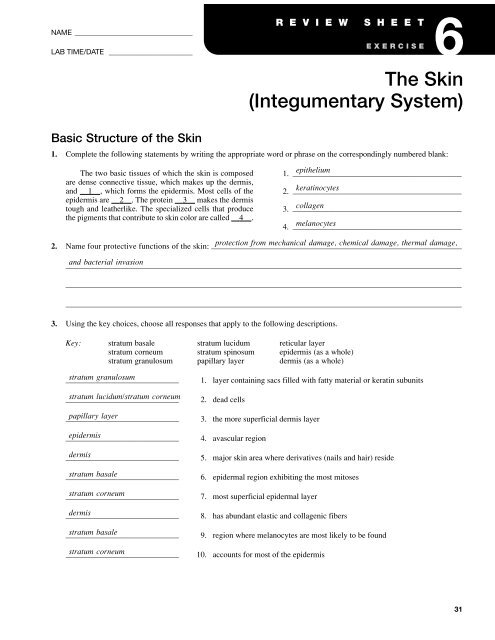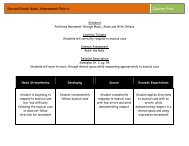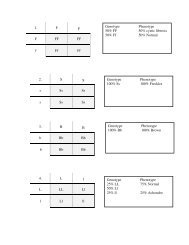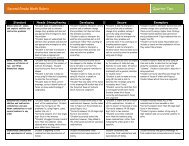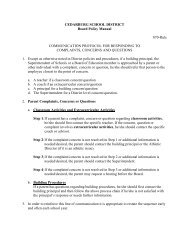You also want an ePaper? Increase the reach of your titles
YUMPU automatically turns print PDFs into web optimized ePapers that Google loves.
NAME ____________________________________<br />
LAB TIME/DATE _______________________<br />
Basic Structure of the <strong>Skin</strong><br />
R E V I E W S H E E T<br />
E X E R C I S E<br />
1. Complete the following statements by writing the appropriate word or phrase on the correspondingly numbered blank:<br />
<strong>The</strong> two basic tissues of which the skin is composed<br />
are dense connective tissue, which makes up the dermis,<br />
and 1 , which forms the epidermis. Most cells of the<br />
epidermis are 2 . <strong>The</strong> protein 3 makes the dermis<br />
tough and leatherlike. <strong>The</strong> specialized cells that produce<br />
the pigments that contribute to skin color are called 4 .<br />
6<br />
1.<br />
epithelium<br />
—————————————————————<br />
2.<br />
keratinocytes<br />
—————————————————————<br />
3.<br />
collagen<br />
—————————————————————<br />
4.<br />
melanocytes<br />
—————————————————————<br />
2. Name four protective functions of the skin:<br />
protection from mechanical damage, chemical damage, thermal damage,<br />
———————————————————————————————<br />
and bacterial invasion<br />
—————————————————————————————————————————————————<br />
—————————————————————————————————————————————————<br />
—————————————————————————————————————————————————<br />
3. Using the key choices, choose all responses that apply to the following descriptions.<br />
Key: stratum basale stratum lucidum reticular layer<br />
stratum corneum stratum spinosum epidermis (as a whole)<br />
stratum granulosum papillary layer dermis (as a whole)<br />
stratum granulosum<br />
——————————————<br />
stratum lucidum/stratum corneum<br />
——————————————<br />
papillary layer<br />
——————————————<br />
epidermis<br />
——————————————<br />
dermis<br />
——————————————<br />
stratum basale<br />
——————————————<br />
stratum corneum<br />
——————————————<br />
dermis<br />
——————————————<br />
stratum basale<br />
——————————————<br />
stratum corneum<br />
——————————————<br />
1. layer containing sacs filled with fatty material or keratin subunits<br />
2. dead cells<br />
3. the more superficial dermis layer<br />
4. avascular region<br />
<strong>The</strong> <strong>Skin</strong><br />
(<strong>Integumentary</strong> <strong>System</strong>)<br />
5. major skin area where derivatives (nails and hair) reside<br />
6. epidermal region exhibiting the most mitoses<br />
7. most superficial epidermal layer<br />
8. has abundant elastic and collagenic fibers<br />
9. region where melanocytes are most likely to be found<br />
10. accounts for most of the epidermis<br />
31
4. Label the skin structures and areas indicated in the accompanying diagram of skin.<br />
epidermis<br />
dermis<br />
Subcutaneous<br />
tissue or<br />
hypodermis<br />
Pacinian corpuscle<br />
(deep pressure receptor)<br />
5. What substance is manufactured in the skin (but is not a secretion) to play a role elsewhere in the body?<br />
<strong>The</strong> skin is the site of vitamin D synthesis for the body.<br />
—————————————————————————————————————————————————<br />
6. How did the results you obtained in Activity 2, “Visualizing Changes in <strong>Skin</strong> Color Due to Continuous External Pressure,”<br />
relate to formation of decubitus ulcers? (Use your textbook if necessary.)<br />
Any restriction of the normal blood supply to the skin results in cell death and, if severe or prolonged, will cause<br />
—————————————————————————————————————————————————<br />
decubitus ulcers.<br />
—————————————————————————————————————————————————<br />
7. Some injections hurt more than others. On the basis of what you have learned about skin structure, can you determine why<br />
this is so? <strong>The</strong> dermis has a rich nerve supply; some with nerve endings that respond to pain. If these bare nerve end-<br />
————————————————————————————————————————————–––<br />
ings are stimulated by injection, a pain message will be transmitted to the central nervous system for interpretation.<br />
—————————————————————————————————————————————————–<br />
32 Review Sheet 6<br />
Hair<br />
shaft<br />
Stratum<br />
Stratum<br />
Stratum<br />
Stratum<br />
Stratum<br />
Dermal papillae<br />
Hair root<br />
Sebaceous gland<br />
Hair follicle<br />
Arrector pili muscle<br />
Reticular layer<br />
Sweat gland<br />
Blood vessel<br />
Hair bulb<br />
Nerve fiber<br />
lucidum<br />
corneum<br />
Adipose cells<br />
granulosum<br />
spinosum<br />
basale<br />
Layers
8. Two questions regarding general sensation are posed below. Answer each by placing your response in the appropriately<br />
numbered blanks to the right.<br />
1–2. Which two body areas tested were most sensitive to touch? 1–2.<br />
lips, fingertips<br />
————————————————–<br />
3–4. Which two body areas tested were the least sensitive to touch? 3–4.<br />
back of calf, back of neck<br />
————————————————–<br />
9. Define adaptation of sensory receptors:<br />
Decline in receptor sensitivity and stimulation with prolonged unchanging<br />
—————————————————————————————————<br />
stimuli.<br />
—————————————————————————————————————————————————<br />
10. Why is it advantageous to have pain receptors that are sensitive to all vigorous stimuli, whether heat, cold, or pressure?<br />
Because all of these stimuli, if excessive, cause tissue damage.<br />
—————————————————————————————————————————————————<br />
Pain receptors do not adapt. Why is this important?<br />
Pain is a warning of actual or potential tissue damage.<br />
—————————————————————————–––––––<br />
—————————————————————————————————————————————————<br />
11. Imagine yourself without any cutaneous sense organs. Why might this be very dangerous?<br />
Many external stimuli (heat,<br />
—————————————<br />
cold, pressure), which can threaten homeostasis, might go undetected and proper protective measures might not be taken.<br />
—————————————————————————————————————————————————<br />
Appendages of the <strong>Skin</strong><br />
12. Using the key choices, respond to the following descriptions. (Some choices may be used more than once.)<br />
Key: arrector pili hair follicle sweat gland—apocrine<br />
cutaneous receptors nail sweat gland—eccrine<br />
hair sebaceous glands<br />
sebaceous glands<br />
————————————————————<br />
hair follicle<br />
————————————————————<br />
sweat gland—eccrine<br />
————————————————————<br />
hair follicle<br />
————————————————————<br />
sweat gland—apocrine<br />
————————————————————<br />
sebaceous glands/hair follicle<br />
————————————————————<br />
hair/nail<br />
————————————————————<br />
arrector pili<br />
————————————————————<br />
sebaceous glands<br />
————————————————————<br />
nail<br />
————————————————————<br />
1. Acne is an infection of a(n) ———————————————–——— .<br />
2. Structure that houses a hair.<br />
3. More numerous variety of perspiration gland that produces a secretion containing<br />
water, salts, and vitamin C; activated by rise in temperature.<br />
4. Sheath formed of both epithelial and connective tissues.<br />
5. Type of perspiration-producing gland that produces a secretion containing<br />
proteins and fats in addition to water and salts.<br />
6. Found everywhere on body except palms of hands and soles of feet.<br />
7. Primarily dead/keratinized cells.<br />
8. Specialized structures that respond to environmental stimuli.<br />
9. Its secretion contains cell fragments.<br />
10. “Sports” a lunula and a cuticle.<br />
Review Sheet 6<br />
33
13. How does the skin help to regulate body temperature? (Describe two different mechanisms.) —————————————————<br />
1. Capillaries in the papillary layer of the dermis allow heat to radiate to the skin surface to cool off the body and<br />
——————————————————————————————————————————————————————————————————————<br />
will constrict blood flow to the dermis temporarily when body heat needs to be conserved.<br />
——————————————————————————————————————————————————————————————————————<br />
——————————————————————————————————————————————————————————————————————<br />
2. Sweat glands secrete perspiration that evaporates and carries large amounts of body heat with it.<br />
——————————————————————————————————————————————————————————————————————<br />
14. Several structures or skin regions are lettered in the photomicrograph below. Identify each by matching its letter with the<br />
appropriate description that follows.<br />
———————— adipose cells f<br />
b<br />
———————— hair follicle<br />
———————— dermis e<br />
d<br />
———————— hair shaft<br />
———————— epidermis a<br />
c<br />
———————— sloughing stratum corneum cells<br />
Plotting the Distribution of Sweat Glands<br />
15. With what substance in the bond paper does the iodine painted on the skin react?<br />
Starch<br />
—————————————————<br />
16. Which skin area—the forearm or palm of hand—has more sweat glands?<br />
Palm of hand<br />
————————————————————<br />
Which other body areas would, if tested, prove to have a high density of sweat glands?<br />
Soles of feet, underarms,<br />
——————————————–<br />
forehead<br />
—————————————————————————————————————————————————<br />
17. What organ system controls the activity of the eccrine sweat glands?<br />
Nervous system<br />
——————————————————————<br />
34 Review Sheet 6<br />
a b c d e<br />
f


